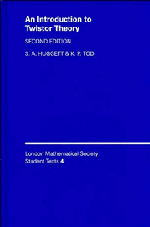Book contents
- Frontmatter
- Contents
- Preface
- Preface to the second edition
- 1 Introduction
- 2 Review of Tensor Algebra and Calculus
- 3 Lorentzian Spinors at a Point
- 4 Spinor Fields
- 5 Compactified Minkowski Space
- 6 The Geometry of Null Congruences
- 7 The Geometry of Twistor Space
- 8 Solving the Zero Rest Mass Equations I
- 9 Sheaf Cohomology and Free Fields
- 10 Solving the Zero Rest Mass Equations II
- 11 The Twisted Photon and Yang–Mills Constructions
- 12 The Non-Linear Graviton
- 13 Penrose's Quasi-Local Momentum and Angular Momentum
- 14 Functionals on Zero Rest Mass Fields
- 15 Further Developments and Conclusions
- 16 Hints, Solutions and Notes to the Exercises
- Appendix The GHP Equations
- Bibliography
- Index
Preface to the second edition
Published online by Cambridge University Press: 25 January 2010
- Frontmatter
- Contents
- Preface
- Preface to the second edition
- 1 Introduction
- 2 Review of Tensor Algebra and Calculus
- 3 Lorentzian Spinors at a Point
- 4 Spinor Fields
- 5 Compactified Minkowski Space
- 6 The Geometry of Null Congruences
- 7 The Geometry of Twistor Space
- 8 Solving the Zero Rest Mass Equations I
- 9 Sheaf Cohomology and Free Fields
- 10 Solving the Zero Rest Mass Equations II
- 11 The Twisted Photon and Yang–Mills Constructions
- 12 The Non-Linear Graviton
- 13 Penrose's Quasi-Local Momentum and Angular Momentum
- 14 Functionals on Zero Rest Mass Fields
- 15 Further Developments and Conclusions
- 16 Hints, Solutions and Notes to the Exercises
- Appendix The GHP Equations
- Bibliography
- Index
Summary
In the eight years since the first edition of this book was published the literature of twistor theory has increased very substantially. There have been several books published whose subject matter overlaps to a greater or lesser extent with ours: Ward and Wells (1990) contains a mathematically more thorough and rigorous account of sheaf cohomology and the machinery from complex analysis necessary for twistor theory than we have found space for; Baston and Eastwood (1989) is a mathematical account of the ‘Penrose transform’ and its generalisation as part of representation theory; Bailey and Baston (1990) is a collection of commissioned reviews which go on in many directions from topics which we touch on more briefly; finally, Mason and Hughston (1990) follows on from Hughston and Ward (1979) by being a collection of articles which had previously appeared in Twistor Newsletter.
None of these precisely duplicates our book and so we have prepared a new edition taking account of some of the developments of the past eight years. The principal changes for the second edition are as follows:
- chapter 9 has been rewritten with a slightly different emphasis. Our intention is to provide a much clearer and more detailed motivation for the notion of a sheaf, with readers new to the subject in mind. Then (as in the first edition) we go on to discuss the elements of íech cohomology.
- chapter 13 has been extended to describe the present status of the original quasi-local mass construction. There has been a lot of work in this area, and also a proliferation of other definitions of quasi-local mass. We describe one of them, that of Dougan and Mason, in detail.
[…]
- Type
- Chapter
- Information
- An Introduction to Twistor Theory , pp. xi - xiiPublisher: Cambridge University PressPrint publication year: 1994



